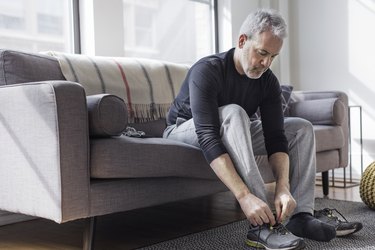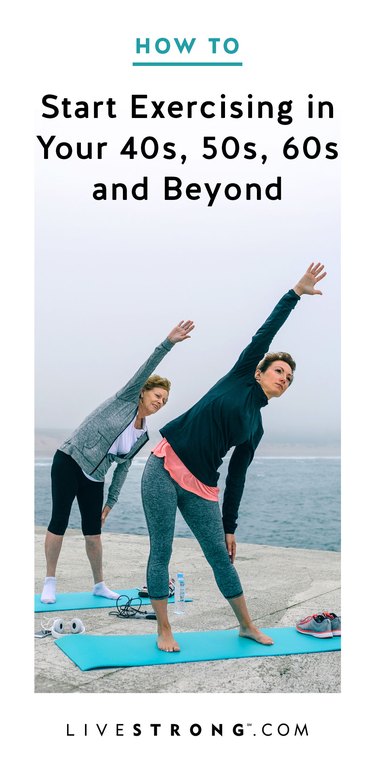
If you're over 40 and haven't exercised in years (or ever), take heart: It's never too late to start working out. Even those who start exercising in their late 70s can reap the benefits of exercise.
So what's the best way to approach exercise at this phase of life? "For anyone who is returning to exercise after a long break — say, several years or more without exercising — it's important to start slow and gradually increase your duration and intensity," says Leanne Pedante, head of the training program at STRIDE, a running-based fitness club in Los Angeles.
Video of the Day
Video of the Day
"As we age, incorporating both cardio and strength work becomes important. Aerobic exercise keeps your heart healthy, while resistance training helps keep bones strong," Pedante says. To help you kickstart a workout routine, here's a decade-by-decade guide to getting (and staying) active.

Exercising in Your 40s
The bad news? "Muscle loss has already begun when you're in your 40s," says Linda Melone, certified personal trainer and founder of Ageless After 50. "This age-related loss of muscle and decline in strength occurs naturally so if you haven't started a resistance training program, now's the time." If you don't, you can expect to lose between three- and five-percent of your muscle mass each decade.
The good news? Even if you haven't been steadily working out, you can start an exercise regimen in your 40s and get up to speed pretty quickly, provided you don't have any health issues or previous injuries, says Tamara Jones, certified personal trainer and a Pilates instructor in New York City.
"While I wouldn't turn around and try to run a marathon tomorrow if you haven't been routinely exercising, you can likely jump into a two- to three-times-a-week exercise schedule," she says. "This could include working with a trainer in a gym or taking an exercise class at your local YMCA or gym."
Unfortunately, this decade can be especially hard on the ladies. "Women in their 40s are just potentially getting into perimenopause," says Debra Atkinson, CEO of Flipping 50. "They may have symptoms of hot flashes, weight gain and more belly fat." But exercise can help mange those symptoms.
How to Start: Moderate activity that includes frequent brisk walks around your neighborhood or leisurely swims at the pool are good options to ease into things, says Mitchell Fischer, fitness manager of Gold's Gym in San Antonio, Texas.
"To get the most cardiovascular benefit, keep this in mind: If you're speaking full sentences and don't feel short of breath, you're not getting the full benefit," he says. "You should only be able to get five to six words out at a time to catch your breath."
You should also add weight lifting to your weekly regimen, starting slowly to avoid injuries and mastering proper form using your body weight before adding resistance. But don't sell your workouts short, either. "If you're doing three sets of 10 reps with a certain weight and don't feel it, you're not challenging yourself," he says. Pick a weight you can comfortably and safely lift but that also provide a challenge on your last two reps.
Working Out in Your 50s
In your 50s, muscle loss accelerates as muscular strength, endurance and muscle mass continue to decrease. "By age 50, metabolism may be down between 10 to 15 percent as a result of a drop in muscle," Melone says.
"In addition, bone density decreases for both men and women and increases the risk of bone fractures." Plus, ligaments also become less "elastic" and hydrated, making overuse injuries more likely, Melone says.
How to Start: It can help to have a few sessions with a personal trainer to assess how you're moving before you throw yourself into a workout regimen, Jones says. A trainer will put you through a series of diagnostic tests to check your flexibility and core strength. This is the perfect time to ask what exercises he or she recommends for your fitness level, workout experience and injury history.
Based on what they tell you, you can amp up your cardio workouts by biking, swimming, rowing or taking brisk walks. And always find the time to strength train. "If you're working hard enough and taking shorter rest breaks between reps, you will get your heart rate up and that will have cardiac benefits," says Morgan Nolte, DPT, a board-certified clinical specialist in geriatric physical therapy in Omaha, Nebraska.
"Weight training will also build your strength, which is so important for body function and weight management, and strong leg and core muscles will improve your balance to prevent falls." Key exercises you can include in your two or three day a week regimen: push-ups, squats and planks. Body-weight exercises like these build functional strength to continue to perform day-to-day activities without injury.
Getting Active in Your 60s and Beyond
This is a tougher stage to jump-start a regimen, but it's not impossible to make it happen. Your goal: Be conservative and consider going back to the basics, Jones says.
"My best advice: If you're patient and consistent you'll reap the rewards," she says. "At this age, I would also recommend working with a trainer at least to start out as this professional will be very helpful in creating a fitness routine for you to follow."
How to Start: Since osteoarthritis may rear its ugly head during this decade, that's all the more reason you should always warm up for at least 10 minutes before every workout, Melon says.
This is also a great time to partner with a friend on daily walks or workouts. "After you retire, your workplace community is gone and isolation becomes increasingly likely," Pedante says. "Group fitness classes are an amazing way to stay not just physically active, but socially active as well." Try Zumba or other dance classes or water aerobics.
At the gym, consider doing treadmill intervals to develop stronger legs, stronger hearts and greater lung capacity. "Speed-walking treadmill intervals on an incline make for a tough workout and if balance is a concern, guardrails provide extra support," Pedante says.
No matter your life stage, do your best to never age yourself out of exercise, Jones says. "I always tell people who haven't exercised in a while to start with a brisk walk," she says. "Then find the methods and intensities that will help you enjoy exercise and keep you motivated to stay consistent. I'd give this same advice to a 20-year-old: Always listen to your body. It will tell you what's working and what isn't."
Is this an emergency? If you are experiencing serious medical symptoms, please see the National Library of Medicine’s list of signs you need emergency medical attention or call 911.